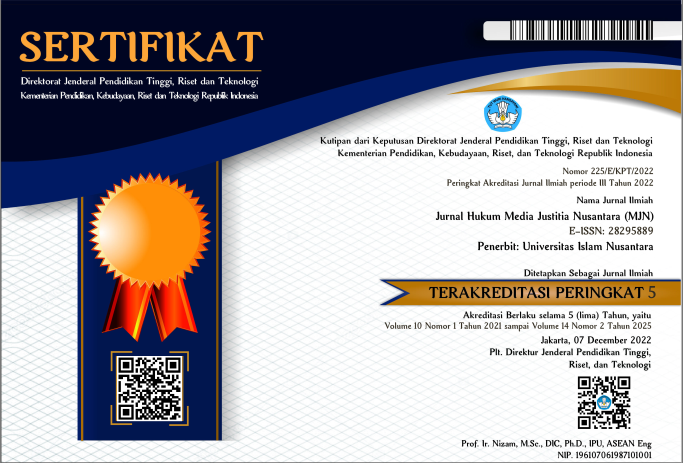Konsep Pembentukan Badan Peradilan Khusus Penyelesaian Perselisihan Hasil Pemilihan Kepala Daerah (PILKADA) Dihubungkan Dengan Kewenangan Transisi Mahkamah Konstitusi Menurut Undang-Undang Nomor 10 Tahun 2016 Tentang Pemilihan Gubernur, Bupati, dan Walikota
DOI:
https://doi.org/10.30999/mjn.v8i1.663Keywords:
Special Court, Regional Elections, Constitutional CourtAbstract
In accordance with Article 157 paragraph (3) of Law Number 10 Year 2016 About the Second Amendment to Law Number 1 Year 2015 On Government Regulation Stipulation in Lieu of Law Number 1 Year 2014 on the Governors Election, Regents and Mayors into Law, Disputes over the final election result shall be examined and tried by the Constitutional Court until the a special judicial body established. The time limit for the special judicial body formation is prior to the national elections implementation, if interpreted systematically with reference to Article 201 paragraph (9) of Law No. 10 of 2016, the implementation will be held in 2024. But it is possible that before the deadline the special judicial body to handle local election matters has been established, so that the transitional authority of the Constitutional Court shall be delegated to the real authority holder.This study aims to find answers to how the Constitutional Court authority during the transitional settlement of dispute over election results of regional heads; and to find alternatives to establishment concept of the Special Judicial Body for Dispute over the Regional Head Elections Results. With the achievement of the objectives of this study is expected to contribute or contribute to the development of legal science in general, Constitutional Law in particular; and can be useful other than as material information, literature, and for the development of legal science concerning dispute over disputes election results of regional heads. The method used in this research is a normative juridical approach that is an approach in legal research using secondary data as the main source. The data analysis used is normative qualitative, which aims to have existing data and then analyzed qualitatively based on existing laws and regulations as a positive legal norm so as not to use numbers and mathematical and statistical formulas. The results of data analysis are presented in the form of description. Concerning the position of the Constitutional Court in exercising its authority in deciding different electoral disputes with previous elections. If in judicial review, the Constitutional Court is 'above' the law, then the Constitutional Court's position in handling the election dispute is under the law and only in the position of executor. As the implementer of the Constitutional Court law must obey and follow the law, so that the authority is not exceeded. The Constitutional Court will provide a model for handling disputes over the results of this election at a special judicial body later. While the concept of a special judicial body dispute election results is a. The institutional model is a special election adhoc court, within the administrative court of the State; b. Scope: only administrative authority related to election result disputes; c. Decentralistic Nature; d. Number of Judges 5 persons, by filling 2 PTUN career judges, 3 adhoc judges; e. Pilkada implementation system: National Serentak starting in 2024; f. Application of Procedural Law The special session of election result disputes is regulated in a separate regulation by adapting the concept of procedural law prescribed by the Constitutional Court at this time, with some confirmation and adaptation of the Constitutional Court.













